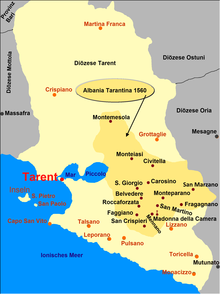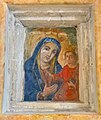Albania Tarantina
With Albania Tarantina (also: Albania Tarentina ; "Tarentine Albania") historians refer to an area south of Taranto , which belonged to Albania Salentina in the historical province of Terra d'Otranto and in which between 1470 and 1530 settlements of Albanian soldiers and refugees (which fled before the conquest of Albania by the Muslim Ottomans ) were founded. The descendants of these settlers belong to the Arbëresh ethnic minority , who are protected in Italy by Law No. 482 “For the Protection of Historical Language Minorities” of December 15, 1999.
14 settlements belonged to Albania Tarantina. The first Albanian settlement to emerge in Tarentino was Faggiano before 1470. In 1514 Albanian families from Fragagnano founded the settlement of Montisparani (today: Monteparano ). Carosino and San Crispieri (today a fraction of Faggiano ) and 1518 Monteiasi were built in 1517 . 1519 received the stratiot captain Lazzaro Mattes (or Lazaro Mathes) for his services to the crown of Charles V , King of Naples (1504-1516), the " Casali " Roccaforzata , San Martino (extinguished) and Belvedere (extinct) with the privilege to let his compatriots colonize them. Montemesola was built around 1520 , followed by San Giorgio in 1524, San Marzano (today: San Marzano di San Giuseppe) in 1530 and Civitella in 1540. Other settlements were Fragagnano and Mennano (already extinct in 1578) with Cappella Santa Maria della Camera .
Albanians also lived in Castellaneta , Martina Franca , Monacizzo , Mottola , Mutunato (today about 3 km outside Avetrana ) and Palagiano .
history
The area was a combat area during the uprising of the local barons (1459-1462) against the King of Naples , Ferdinand I (1458-1494) from the Spanish house of Trastámara, which was fomented by the French . The head of the barons was Giovanni Antonio Orsini del Balzo , Prince of Taranto , on the side of the pretender René of Anjou . In the years 1459, 1460 and 1461 Ferdinand I was repeatedly forced to ask the Albanian prince Gjergj Kastrioti, known as Skanderbeg , for support.
After the troops of the rebel Giovanni Antonio Orsini del Balzo were defeated in Barletta and Trani , Skanderbeg's forces turned south to the Principality of Taranto , where they left havoc. They felled the fruit trees, set the houses on fire and let the residents who resisted "feel the sharpness of the sword". From a correspondence from October 1460 between Giovanni Antonio Orsini del Balzo and Skanderbeg we know that the soldiers of Skanderbeg sacked the area east of Taranto. Orsini accused Skanderbeg of having "plundered his fields" and " ... Dispoliasti agros meos et in meos subditos crudeliter debacchatus es, bellum, primum intulisti ... " (cruelly acted against his subjects in the art of war.)
Giovanni Antonio Orsini del Balzo died under mysterious circumstances between November 14th and 15th, 1463. He was strangled by Paolo Tricarico in the castle of Altamura in what is now the province of Bari . His principality was incorporated into the Kingdom of Naples by King Ferdinand I in 1465.
The land destroyed by the Albanian soldiers themselves was later to become Albania Tarantina. The soldiers who preferred to stay in the Kingdom of Naples and the Albanian refugees who came to the Kingdom of Naples after the death of Skanderbeg (1468) were granted privileges such as ten years of tax exemption and full administrative autonomy.
While the Arbëresh communities in Abruzzo , Molise , Campania , Northern Apulia , Basilicata , Calabria and Sicily are fairly well known where they came from, this is not the case with Albania Tarantina.
religion
The Albanians brought their Albanian language, their customs and traditions as well as their religion according to the Greco-Byzantine rite to their new homeland from their native southern Albania . With the bull of 1536 Pope Paul III. to the Albanians in Italy full recognition within Catholicism .
The parishes of Albania Tarantina have lost their Greco-Byzantine rite over the centuries and, in the first two centuries , changed to the Latin rite under pressure from the Archbishop of Taranto, Lelio Brancaccio .
When Lelio Brancaccio paid a visit to the "Albania Tarantina" in 1578, he found the following dads:
- Belvedere: Todaro Xafilo
- Civitella: Giovanni Turco, Kapelan
- Carosino: Papas Duca and the chaplain Demetrio Capuzio
- Faggiano: Pietro Pigonati
- Monteparano: Demetrio Sirchio
- Roccaforzata: Pietro Psatillo and Demetrio Palumbo
- San Crispieri: Lazaro Borschi
- San Giorgio Jonico: Luca Papocchia
- San Martino: Demetrio Savina
- San Marzano: Demetrio Cabascia
Remnants of Albanian culture
In some places there are still some architectural clues (typical chimneys, churches or remains of churches, ruins) of the Arbëresh.
In the historic center of Carosino you can still find a typical Arbëresh chimney in Largo Dante nos. 43–41 . To the northeast of Carosino was once the Casale Civitella, of which only the Masseria can be seen today.![]()
![]()
In Monteiasi today there are no other traces apart from a few typical Albanian surnames.
About 300 meters outside of San Crispieri (today a fraction of Faggiano) are the ruins of the Chiesa di Santa Maria di Costantinopoli .
![]()
On the road from Taranto to San Giorgio Jonico there is another typical Arbëresh chimney in Via Simone Veil . Another Arbëresh chimney is in Via Cesare Battisti near the Castello D'Ayala Valva in Largo Osanna , and in Via Madonna della Croce there is the Cappella della Madonna della Croce , which was built where the Church of Santa Maria was once built della Presentazione the Arbëresh stood. From Via Pier Giovanni Zingaropoli you can see the remains of the former Casale Belvedere.![]()
![]()
![]()
![]()
About 2 km southeast of Roccaforzata is the pilgrimage church of Santa Maria della Camera and the remains of Casales Mennano.![]()
![]()
In San Marzano di San Giuseppe in Largo Prete there is the Palazzo Capuzzimati (also: Palazzo Marchesale, Palazzo Casalini) from the 16th century with the private Chiesa San Gennaro of the Casalini family , in Via Giorgio Castriota there are two ancient arbëresh houses with the typical Albanian chimneys and three km northwest of the center is the church of the pilgrimage site " Madonna delle Grazie " from the 17th century, the facade of which is decorated with elements of the Albanian school .
![]()
![]()
![]()
Today San Marzano di San Giuseppe is the only place that has preserved the conservative pre- Ottoman Albanian language (Gluha Arbëreshë) as well as some of the traditions, customs, songs and dances of the Albanian homeland.
literature
- Giacomo Arditi: La corografia fisica e storica della provincia di terra d'Otranto . Ammirato Scipione, Lecce 1879 (Italian, archive.org ).
- F. Antonio Primaldo Coco: Casali Albanesi nel Tarentino . Grottaferrata 1921 (Italian, dimarcomezzojuso.it [PDF]).
- F. Antonio Primaldo Coco: Faggiano - Primo Casale Albanese nel Tarentino . Pappacena, Taranto 1929 (Italian, dimarcomezzojuso.it [PDF]).
- F. Antonio Primaldo Coco: Gli albanesi in Terra d'Otranto . In: Japigia (= Rivista di archeologia, storia e arte . Ser. NS, Volume 10 ). Bari 1939, p. 338 (Italian, emeroteca.provincia.brindisi.it [PDF]).
- Pietro Dalena: Insediamenti albanesi nel territorio di Taranto, (Secc. XV – CVI), Realtà storica e mito storiografico, Miscellanea di Studi Storici-Università della Calabria . 1989, p. 36-104 (Italian, vatrarberesh.it [PDF]).
- José M. Floristán: Sociedad, economía y religious en las comunidades griega y albanesa de Nápoles y Sicilia: nuevos documentos inéditos . In: Erytheia: Revista de estudios bizantinos y neogriegos . tape 37-2016 . Asociación Cultural Hispano-Helénica, Madrid 2016 (Spanish).
- Giuseppe Miccoli: Roccaforzata nell'Albania tarantina. Studi e ricerche . Angelini & Pace, Locorotondo 1964 (Italian).
Web links
- Albania Tarantina. Monteparano.com(Italian).
- Bianca D'Amore: L'Albania di Terra d'Otranto. Bpp.it (Italian).
Remarks
- ↑ Casale (plural casali) is the Italian name for a house or a group of houses in the country.
- ↑ In Albania Salentina, Albanians lived in Alessano , Alliste , Aradeo , Castro , Erchie , Maglie , Mesagne , Muro Leccese , Nardò , Ostuni , Patu, Palesano (extinct; near Gisona), San Donaci , Taurisano , Torchiarolo , Veglie , Brindisi and Lecce .
- ↑ Secular clergyman in the Orthodox Church
Individual evidence
- ↑ Legge 15 December 1999, n. 482 Norme in materia di tutela delle minoranze linguistiche storiche. Retrieved October 25, 2016 (Italian).
- ^ Faggiano - Primo Casale Albanese nel Tarentino, p. 35
- ↑ Gli albanesi in Terra d'Otranto, p. 337.
- ^ F. Antonio Primaldo Coco: Casali Albanesi nel Tarentino. Pp. 58, 61.
- ↑ José M. Floristán: Sociedad, economía y religious en las comunidades griega y albanesa de Nápoles y Sicilia: nuevos documentos inéditos. P. 132.
- ^ A b c F. Antonio Primaldo Coco: Casali Albanesi nel Tarentino. P. 78.
- ↑ Emidio Tomai Pitinca: Istituzioni ecclesiastiche dell'Albania tarantina (= Collana dell'Università degli Studi di Lecce Dipartimento di Scienze Storiche e Sociali Saggi e Ricerche . Volume 16 ). Congedo Editore, Galatina 1984, ISBN 88-7786-251-3 , pp. 12 (Italian).
- ^ F. Antonio Primaldo Coco: Casali Albanesi nel Tarentino. P. 65.
- ^ Gennaro Maria Monti: La spedizione in Puglia di Giorgio Castriota Scanderbeg ei feudi pugliesi suoi della vedova e del figlio . In: Palaver . 4 ns, no. 1 . Università del Salento, 2015, p. 130, 138 (Italian, siba-ese.unisalento.it [PDF]).
- ^ Scanderbeg eroe anche in terra di Puglia by Alfredo Frega, Appunti di storia, N. 5, April 2005. Retrieved on March 10, 2017 (Italian).
- ↑ Pietro Pompilio Rodotà: Dell'origine, progresso e stato presente del rito greco in Italia, osservato dei greci, monaci basiliani, e albanesi . Room 1763, p. 18 (Italian, online version in Google Book Search).
- ^ Darcy Carvalho: The Commentaries of Pius Pp II Pontifex Maximus. Commentarii de rerum memorabilium quae temporibus suis contigerunt Pius Pp II (1405–1464) . São Paulo 2014, p. 306 ff . (Latin, Text Archive - Internet Archive ).
- ↑ Aurora Martino: Giovan Girolamo II Acquaviva d'Aragona (1604 c. – 1665) Signore feudale del Mezzogiorno spagnolo . Universidad de Valladolid, Valladolid 2012, p. 68 (Italian, uvadoc.uva.es [PDF]).
- ^ Brindisi al tempo dei re aragonesi sul trono di Napoli. (PDF) brindisiweb.it, accessed March 8, 2017 (Italian).
- ^ Il principato di Taranto. Borsci1.com, accessed March 10, 2017 (Italian).
- ^ Dionigi Cristian Lentini, Tommaso Gentile: Cronologia della Storia di Mottola . Mottola 2009, p. 11 (Italian, online version in Google Book Search [accessed March 11, 2017]).
- ^ Giornale enciclopedico di Napoli . tape 2 . Orsiniana, 1807, p. 155 (Italian, online version in Google Book Search).
- ↑ Margherita Forte and Alessandra Petruzza, collaborators at the information desk of Vena, a parliamentary group of Maida, Le origini della minoranza linguistica albanese (PDF, The origins of the Albanian-speaking minority), 2005, accessed October 25, 2016.
- ^ Giuseppe Maria Viscardi: Tra Europa e “Indie di quaggiù”. Chiesa, religosità e cultura popolare nel Mezzogiorno . Storia e Letteratura, Rome 2005, ISBN 88-8498-155-7 , p. 377 (Italian, online version in Google Book Search).
- ↑ Pietro Pompilio Rodotà: Dell'Origine, Progresso e Stato presente del Rito Greco in Italia, osservato dai greci, monaci basiliani e albanesi, Libro III, Capo. III . Biblioteca Vaticana, Rome 1763, p. 59 (Italian, online version in Google Book Search).
- ↑ Emidio Tomai-Pitinca: Emanuele Cartofilaca Una proposta di "diakonia" per i Greco-Albanesi del mezzogiorno d'Italia . Associazione Cattolica Italiana per l'Oriente Cristiano, Palermo 1982, p. 19 (Italian, dimarcomezzojuso.it [PDF]).
- ^ F. Antonio Primaldo Coco: Casali Albanesi nel Tarentino. P. 49.
- ↑ Pietro Dalena: insediamenti albanesi nel territorio di Taranto, (. Secc XV-CVI), Realtà storica e mito storiografico, miscellanea di Studi Storici-University of Calabria . 1989, p. 66 (Italian, vatrarberesh.it [PDF]).
- ↑ Historical details. Comune.faggiano.ta.it, accessed June 22, 2018 (Italian).
- ^ F. Antonio Primaldo Coco: Casali Albanesi nel Tarentino . Grottaferrata 1921, p. 53 (Italian, dimarcomezzojuso.it [PDF; 12.0 MB ; accessed on March 10, 2017]).

















